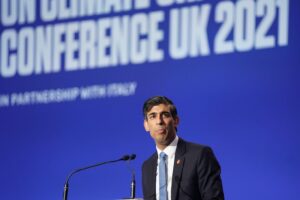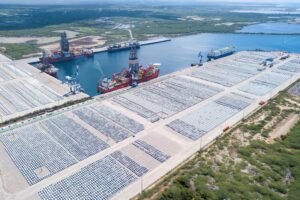
Analysis: How the UK has spent its foreign aid on climate change since 2011
Josh Gabbatiss
10.11.23Josh Gabbatiss
11.10.2023 | 2:35pmSince 2011, the UK has spent at least £12.63bn on 490climate-related projects in developing countries from Afghanistan to Zimbabwe.
A new investigation by Carbon Brief reveals exactly how much of the UK’s foreign-aid budget is being used – and how – to help nations in the global south to cut emissions and better prepare for rising temperatures.
Freedom-of-information (FOI) requests submitted to the UK government have yielded new, detailed information about more than a decade of foreign-aid spending on climate change.
This comes at a time of intense scrutiny for the UK’s climate-finance spending, which it is legally bound to deliver under the terms of theParis Agreement.
The government has slashed its aid budget and, asCarbon Brief’s analysis reveals, fallen behind on itspledgeto spend £11.6bn on climate finance between 2021 and 2026.
Key findings from Carbon Brief’s analysis include:
- Annual climate finance spending has more than tripled from£392.5m in 2011/12 to nearly £1.40bn in 2022/23.
- Ethiopiahas received the most single-country funding overall since 2011, a total of £377.5m. Kenya, Bangladesh and Uganda were also major recipients.
- Combined with government-reported public and private finance “mobilised” by UK funds, the UK’s total climate-finance contribution reached £26.49bn by 2023.
- Around 80% of climate funds go to projects targeting “developing countries” in general or regional funds, which are often run by large multilateral institutions.
In this analysis, Carbon Brief walks through the key findings and trends that emerge from this 12-year dataset.
- Carbon Brief’s FOI and project database
- How much climate finance has the UK spent?
- 英国气候融资用于哪里?
- What results has this climate finance produced?
- Methodology
Carbon Brief’s FOI and project database
Developed countries, such as the UK, have committed to providing “climate finance” to developing countries to help them cut emissions and prepare for a warming world.
In practice, this money is generally drawn from countries’ foreign-aid budgets. In the UK, this kind of aid is termedInternational Climate Finance(ICF).
The nation has been supporting ICF projects since 2011 and, throughout this period, it has funded everything fromprovidinghouseholds in Nepal with solar power toensuringflood-stricken communities in Malawi have enough to eat.
Climate finance is a highlypoliticisedissue and developed countries are under intense pressure to deliver the money they have promised repeatedly to developing countries – and to spend it in ways that are “efficient” and achieve the greatest impact.
Specifically, they have astill-outstanding pledgeto raise $100bn annually by 2020 and nowmust decideon amore ambitious goalby 2024. There are also questions around whether rich countries, including the UK, are paying their “fair share” based on their historic responsibility for climate change.
Over the past decade, the UK has been the world’sfifth-largestnational provider of climate finance after – in descending order – Japan, Germany, France and the US, according to theOrganisation for Economic Co-operation and Development(OECD).
Carbon Brief carried out an earlier FOI request in 2017, obtaining information about all the climate finance projects the UK had funded since 2011, the year when ICF began. The findings weremappedand presented in full.
The UK government provides a catalogue of its foreign-aid projects on theDevelopment Trackerwebsite. However, while this service allows users to search for projects with an ICF component, it does not provide the breakdown or percentage of how much of each budget is solely allocated for ICF.
The government has also beensubmittingdetailed information about how much funding from its foreign-aid projects is “climate-specific” to the UN. But these reports contain less information than Development Tracker and only go as far as 2020.
Given this, Carbon Brief has successfully repeated its earlier FOI, this time for the financial years 2017/18 to 2022/23. The government provided this data to Carbon Brief in May 2023.
The resulting data has now been combined with the original dataset, plus data extracted from Development Tracker project pages, to produce a new interactive table detailing every project that includes ICF spending between the financial years 2011/12 and 2022/23 – and the amount of funding that is climate-specific for each one. This can be viewed below.
The total includes £12.63bn of climate finance spent across 490 projects over this 11-year period.
Many ICF projects overseen by theForeign, Commonwealth and Development Office(FCDO) and its predecessor theDepartment for International Development(DFID) are only partly related to climate change, meaning they may also cover other issues, such as education and healthcare. For these projects, only the climate-relevant proportion of spending – as determined by the FCDO – is included in Carbon Brief’s database.
Virtually all of the money included in this table is straightforward ICF. However, in their FOI responses, government departments also provided some additional funds that are counted towards their climate-finance totals.
These include “R&I [research and innovation] funds” – namely theNewton Fundand theGlobal Challenges Research Fund——支持科研发展中countries. Between 2018 and 2023, £117.5m from these funds was used as climate finance. (These funds cover a range of projects but have been grouped together here under one project name.)
虽然这些基金没有最初代为计算ds the UK’s climate-finance goals, budgetary pressure over the years has led to climate-related projects from these schemes being used to make up ICF totals. The reverse has also happened when climate-related R&I projects were in danger of losing funding.
Another notable outlier is funding for “COP costs”. The government counts £99m that it spent hosting theCOP26 climate summitin Glasgow in 2021 towards its goals.
(A read-only Google Sheet with the full dataset can be viewedhere. For more information about this data, see theMethodologysection at the end of the article.)
How much climate finance has the UK spent?
The UK has more than tripled its annual climate-finance spending from £392.5m in 2011/12 to nearly £1.40bn in 2022/23.
In total, it has spent £12.63bn of development aid on ICF programmes across this period. Thisamounts toaround 8% of total foreign-aid spending.
However, ICF funding has dropped over the past two years from a peak of £1.56bn in 2020/21, despite a 2019 government target to significantly scale up climate finance to £11.6bn over five years out to 2025/26. (For more on this dip in climate finance, see Carbon Brief’s separate analysis.)

Three government departments have been responsible for the UK’s climate-finance projects, although they have shifted titles and responsibilities several times over the past decade.
The majority of projects – 65% of the total funding across 417 projects – have been handled by DFID and, since September 2020, FCDO, which replaced it when the department was rolled into the Foreign and Commonwealth Office.
The second largest portion – 32% of total funding across 46 projects – has been overseen by the energy department, which has been known as theCha能源和气候nge(DECC), theDepartment for Business, Energy and Industrial Strategy(BEIS) and, since February 2023, theDepartment for Energy Security and Net Zero(DESNZ).
The remaining 3% has been handled by theDepartment for Environment Food and Rural Affairs(Defra) across 27 projects. (Unlike the other departments, which released “provisional” data for 2022/23 to Carbon Brief, Defra declined to share data for this year.)
英国气候融资用于哪里?
The map below shows where the UK has directed single-country funds since 2011 and the total spending in these nations across the 11-year period.
Countries in shades of blue have received climate finance from the UK and those in orange would beeligibleto receive it, but have not. (Those in grey are not eligible to receive aid.)

Many factors contribute to which countries receive ICF funds from the UK, including vulnerability to climate change, regional expertise and diplomatic ties.
“It is aid money that is subject to the whim of the donor, who will naturally be funding what is aligned to its national interest – some would argue rightly so,”Faten Aggad, a climate diplomacy expert and adjunct professor at theUniversity of Cape Towntells Carbon Brief.
Of the 37 nations and territories that have received single-country funds, 17 are members of theCommonwealth– a group primarily made up of former British Empire colonies. A further two recipients, St Helena and Montserrat, remain British overseas territories.
Eighteen of the recipients are “least developed countries” (LDCs) – a UN grouping of 46 predominantly African states that are entitled to preferential access to aid. Only three recipients are independent small-island territories – Dominica, Haiti and Fiji.
Ethiopia is, by far, the biggest recipient of single-country funds, with £377.5m in total.
Most of this money has been provided through two sizable programmes aimed at increasing the Ethiopian government’s resilience to humanitarian shocks and increasing food security.
Case study:Productive Safety Net Programme
Location:Ethiopia
ICF spend:£190.8m between 2015/16 and 2019/2020
Asocial safety net programme– one of the largest in Africa – launched by the Ethiopian government and a group of donors in 2005 to help food-insecure households. It involved handing out food and cash either in exchange for labour on public works projects or unconditionally, for those who cannot work. The UK classed part of its contribution as climate finance because the public works being built include climate-proofing local infrastructure and the rehabilitation of habitats such as shrubland, which it says will absorb carbon dioxide (CO2). Boosting people’s food security also helped to “build resilience to climate shocks”. Money has been provided both directly to the Ethiopian Ministry of Finance and Economic Cooperation and to the World Bank, which also supports the project.
Several major recipients are emerging economies, which often have high emissions and are relatively wealthy.
According to the UK’sIndependent Commission for Aid Impact(ICAI), these funds areoften providedas loans, with the aim of attracting private investment and potentially creating opportunities for UK firms.
India has seen a dramatic increase in single-country funding. Carbon Brief’s previous analysis in 2017 showed that the UK had spent a total of £5m of ICF there, but now, largely thanks to a new National Investment and Infrastructure Fund, the total has risen to £144.8m.
Clare Shakya, a climate finance expert at theInternational Institute for Environment and Development(IIED), tells Carbon Brief:
“The UK’s development finance has traditionally been focused on those countries that most need support from among Britain’s ex-colonies, such as Bangladesh, Uganda and Kenya, and those which hold a strategic interest for the UK, such as Ethiopia, India or Nepal. The current government has been expanding the countries that it partners with on development, largely on the basis of strategic interest.”
As the chart below shows, only £2.55bn has been handed out as direct, single-country funds. The remainder is spent either through regional funds or even more broadly on “developing countries” in general.
Case study:Supporting structural reform in the Indian power sector
Location:India
ICF spend:£13.1m between 2017/18 and 2022/23
This project aims to improve the reliability of electricity supply in India through power-sector reform. It worked alongside a decentralised renewables programme also funded by the UK. In line with the government’s approach to providing aid to India, this project aimed to assist through “world-class” expertise, “not through traditional grant support”. The consultancyKPMGwas hired to provide “technical assistance” to the Indian Ministry of Power and other agencies. Other organisations are also brought into the project. TheShell Foundation– a charitable initiative of the oil company – was hired to promote the employment of women in the energy sector. TheBehavioural Insights Team, originally set up by the UK government and dubbed “the nudge unit”, was also employed to apply behavioural insights to the Indian power sector and “influence customer behaviour”.
This is because most ICF is channelled through multilateral development banks, large consultancies and other organisations that ultimately decide how the money will be spent, although often with oversight from the UK and other contributors. (See:Who is the UK paying to run these projects?)

What results has this climate finance produced?
Each year, the UK government publishes areportlaying out the impact its climate finance has had and its progress towards a selection of key performance indicators (KPIs). This includes the additional finance that its ICF funds has “mobilised”.
“Mobilised” refers to money from private sources – such as banks and companies – or from external public sources – such as UN bodies, development banks and the governments of recipient countries – which has been spent on climate action due to initial investment using ICF aid money.
These figures are important, not least because the annual $100bn (£80bn) goal that developed countries have promised to meet includes “mobilising” such additional sources.
The chart below shows how, according to the government’s reporting on its KPIs, these climate-finance sources have grown between 2014 and 2023. Combined with ICF spending, they bring the UK’s cumulative total to £26.49bn by 2023. (The government notes that only 297 projects have reported this additional impact, so the real total could be larger.)
Case study:UK Caribbean Infrastructure Fund
Location:Caribbean
ICF spend:£69.5m between 2016/17 and 2022/23
As part of a “major re-engagement between the UK and the Caribbean” in 2015, this fund was launched to build “climate-resilient” infrastructure in eight Commonwealth Caribbean nations and Montserrat, a UK overseas territory. It was given a boost in 2018 to support reconstruction in Dominica and Antigua and Barbuda, after hurricanes Irma and Maria tore through the region.The fund is run largely by theCaribbean Development Bank(CDB), a multilateral institution based in Barbados, with small team of UK government staff to support its delivery.

Beyond additional financing, the government also has a range of additional KPIs. The most recentreporton their progress includes cumulative data up to 2022/23.
The table below shows progress on these indicators between 2014/15 and 2022/23.
Among other things, the government states that its ICF spending has “supported” nearly 102 million people to deal with the impacts of climate change and “reduced or avoided” 87m tonnes of carbon dioxide equivalent (MtCO2e).
As of 2023, the UK hasdoubledits list of KPIs to include new metrics such as the number of social institutions with improved access to clean energy and area of deforestation avoided.
Methodology
This analysis is based on a full dataset of ongoing and closed ICF projects, between 2011/12 and 2022/23, that Carbon Brief has assembled using FOI data and data extracted from government web pages.
The government’sDevelopment Trackerwebsite provides information on all of the development aid projects that the UK has spent money on, divided up among the departments that administer them. It includes data on the total budget of each project, but it does not include the breakdown of how much money in each budget is specifically set aside to address climate change.
Similarly, while the UK’s submissions to the UN include data on “climate-specific” finance, it does not consistently include sufficient information to identify all of the projects and only go as far as 2020.
To obtain this data, Carbon Brief sent FOI requests on 17 March 2023 to the three government departments responsible for ICF projects – FCDO, Defra and DESNZ. These requests asked for project-level annual ICF spend for the period 2017/18 to 2022/23 and the project ID code for each project.
The data was provided by all three departments towards the end of May. FCDO and DESNZ provided figures for 2022/23, noting that they are “provisional”. Defra, which accounts for only around 3% of total ICF spend, declined to provide these figures as it said the department was “yet to finalise” them.
This was then combined with annual ICF data for the period 2011/12 to 2016/17, which Carbon Brief had obtained in 2017 with another FOI request. This was achieved using the project codes to match up projects that had continued across these two periods. Further information, such as project names, descriptions and start/end dates, was then added using data scraped from ICF-taggedDevelopment Trackerpages in June 2023 – again using project codes to match up projects. Data was extracted by Carbon Brief’s Tom Prater usingImport.ioandOctoparse.
The dataset can be viewed in thisread-only Google Sheet, which includes an annual breakdown of spending. There are a few points to consider when exploring this data:
- A handful of projects had changed names, changed project IDs or moved to different departments. Carbon Brief matched up these projects with the correct details as far as possible, checking on specific details with the relevant departments.
- There remain 16 projects where no Development Tracker pages could be identified and, therefore, some information is missing (four of these include work in Afghanistan, so might have been removed for security reasons). This does not include COP26 costs and R&I funds, which do not have Development Tracker pages.
- For 10 of those projects, amounting to £13.27m in funds, a project location could not be identified and this will have a small effect on the country analysis. “COP costs”, which amount to £99m, also do not have a location.
- Some lines show negative spending. This can occur for several reasons, including a case where an investment funded through ICF has brought in returns, or if ICF spend has been incorrectly recorded and corrected, following quality assurance.
- The total number of ICF projects is higher than the number recorded on the government’s Development Tracker website, due to the FOI responses including a more comprehensive list of projects.
There are also issues with a number of Development Tracker pages, with many showing incorrect details at the time of publication and some of the links to project pages breaking.
This would not impact the ICF totals quoted in the article, which are derived from FOI requests, but may result in discrepancies when comparing the data included in the interactive table with project pages. The government has confirmed to Carbon Brief that it is aware of these issues.
-
Analysis: How the UK has spent its foreign aid on climate change since 2011





